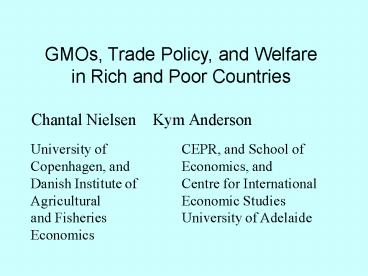GMOs, Trade Policy, and Welfare - PowerPoint PPT Presentation
1 / 21
Title:
GMOs, Trade Policy, and Welfare
Description:
GMOs, Trade Policy, and Welfare in Rich and Poor Countries Chantal Nielsen Kym Anderson University of Copenhagen, and Danish Institute of Agricultural – PowerPoint PPT presentation
Number of Views:172
Avg rating:3.0/5.0
Title: GMOs, Trade Policy, and Welfare
1
GMOs, Trade Policy, and Welfare in Rich and Poor
Countries
Chantal Nielsen Kym Anderson
University of Copenhagen, and Danish Institute of
Agricultural and Fisheries Economics
CEPR, and School of Economics, and Centre for
International Economic Studies University of
Adelaide
2
Genetically modified organisms (GMOs) in
agriculture
- Proponents argue that GMOs can offer
- Increased ag productivity higher farm profits
- Less use of chemicals
- Better use of natural resources
- More nutritious foods
3
Genetically modified organisms (GMOs) in
agriculture
- Opponents are concerned about
- The environment
- Food safety
- Market power
- Ethics
4
Rich countries can afford to be
critical Developing countries face a different
trade-off between potential risks and the need
for productivity increases in food production and
lower food prices
Developing countries also need to consider how
GMO policy actions may affect - market
access - world market prices -
global food demand
5
- Three types of technical barrier to trade
- Import bans
- Technical standards
- Information remedies
Standards concerning GMOs have not yet been
established but there is a possibility of
import bans and a demand for labels, which is
leading to
- National GMO regulations
- International trade agreements
6
- National GMO regulations
- European Union
- De facto moratorium since June 1999
- Labelling required on all GMO-inclusive foods
- United States
- Flexible permit procedure
- Labelling of GMOs is generally not required
- Others are also beginning to regulate GMOs,
- with some (e.g. Sri Lanka) already banning their
importation
7
- International trade agreements
- (i) The Cartagena Protocol on Biosafety
- Objective Ensure safe transboundary movement of
GMOs - Allows govts to decide whether or not to accept
- GMO imports and under what conditions
- Lack of scientific evidence shall not prevent a
country in taking action - May contain GMOs label on primary products
8
- International trade agreements
- (ii) The WTO
- The WTO also acknowledges the rights of a
- country to protect its environment and to ensure
food safety and information for consumers. - But there are rules on how such trade-related
- measures may be used to achieve these goals.
9
- International trade agreements
- Potential conflict between Protocol and WTO
rules, - particularly concerning
- WTOs SPS agreement requires scientific evidence
- The product/process distinction like products
10
Empirical analysis
Quantify the effects of GMO adoption by some
producers, and regulations on production, trade
and welfare in other countries
Two regulatory response scenarios 1. Western
Europe imposes a ban on GM imports as permitted
in the Biosafety Protocol 2. The WTO rules
against the import ban, but allows the labels as
defined in the Protocol
11
- Modelling framework
- Standard global economy-wide CGE model
- Vertical and horizontal linkages, bilateral trade
- GTAP database 17 sectors and 16 regions
Representation of GMO technology 5 TFP shock
for maize and soybean in North America,
Mexico, Southern Cone of LA, India, China,
Rest of East Asia and South Africa All other
regions do not adopt GM crops
12
- 1. WEU import ban scenario
- Imports of maize and soybeans banned from
GM-regions - Protocol label enables identification of GMOs
- Labelling costs are assumed to be negligible
- 2. Protocol label scenario
- May contain GMOs label is perceived as
uninformative - Partial shift in WEU preferences away from
imports and in favour of domestic products - WEU producers signal non-GMO status through
country of origin labels
13
Selected results of WEU ban and Protocol label
scenarios Percentage change from base with no GMO
regulations
14
Selected results of WEU ban and Protocol label
scenarios Percentage change from base with no GMO
regulations
15
Selected results of WEU ban and Protocol label
scenarios Welfare changes and their decomposition
(per year)
16
Selected results of WEU ban and Protocol label
scenarios Welfare changes and their decomposition
(per year)
17
Selected results of WEU ban and Protocol label
scenarios Welfare changes and their decomposition
(per year)
18
Selected results of WEU ban and Protocol label
scenarios Welfare changes and their decomposition
(per year)
Global welfare changes Base with no GMO
regulations 9.9 billion USD WEU import ban
scenario 3.4 billion USD Protocol
label scenario 8.5 billion USD
19
- What do these results indicate about the effect
of GMO regulations on production, trade welfare - Almost all countries gain from selected countries
adopting GMO technology if there - are no GMO trade regulations
- But this is so for different reasons,
- depending on
- - whether or not GMO crops are produced
nationally - - nations net-exporter status in the
particular crop - - initial price distortionary policies
20
2. WEU import ban is very costly for WEU itself
- and production in adopting countries might fall
in spite of positive TFP shock, depending on
importance to them of WEU and other export
markets - non-adopters gain market shares in
WEU
3. A market-based solution is far better for both
adopters and WEU - but other non-adopting
regions lose in terms of a relative
productivity decline and increased competition on
international markets
21
Future analytical work on the economics of GMOs
- Need to fine-tune empirical evidence of
productivity impact of GM technology - 2. Consumer reactions to regulations, or lack
thereof, depend on how well the regulations meet
national policy objectives - 3. Split the models national production and
marketing systems into GMO and non-GMO products































